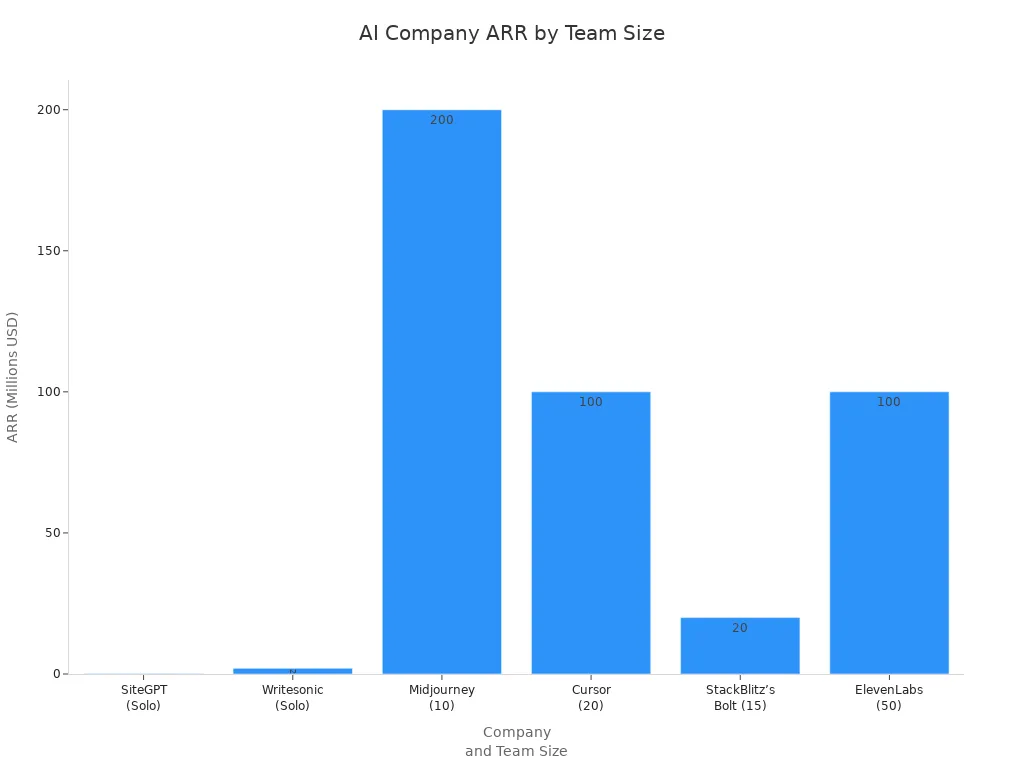High MRR AI app stories that inspire beginners

Real stories of high mrr AI apps can spark your motivation and show you what is possible. You can learn practical steps from founders who started as solo builders or small teams. Some founders bring technical skills, while others focus on strategy or operations. Many teams find success by sharing equal power and building trust. You might notice that a mix of backgrounds and clear communication often leads to growth. Every journey looks different, but each one proves that you can start wherever you are.
Key Takeaways
Monthly Recurring Revenue (MRR) means you get steady money from subscriptions. It helps you plan and grow your AI app business.
Good AI apps fix real problems. They give users a great experience. They use clear pricing like subscriptions or freemium plans.
Build your app fast. Listen to your users. Focus on a small group of people. This can help you get high MRR, even if you work alone or in a small team.
Use no-code tools and AI APIs to make your app quickly. Test your ideas early. Make changes based on what users say.
Do not make common mistakes. Do not think AI can do everything. Do not ignore data quality. Do not forget about marketing. Keep your app simple, fair, and focused on users.
High MRR Meaning
MRR Defined
You need to know what Monthly Recurring Revenue (MRR) means if you want your AI app to do well. MRR is the regular money your company gets each month from people who pay for your subscription product or service. This number shows you how much money you make on average every month, even if you have different prices or payment times. MRR does not count one-time fees. It only looks at the steady money from subscriptions.
MRR lets you see how your business is doing and if it is growing. You can use it to guess how much money you might make later and to help you make good choices for your company. For SaaS and AI apps, MRR counts new sign-ups, renewals, upgrades, and accounts that come back. It also keeps track of money lost when people cancel or pay less. When you watch your MRR, you get a clear idea of how your business is working.
Tip: Always keep one-time payments out of your MRR math. This makes your numbers right and stops you from getting confused.
Why It Matters
MRR is important because it gives you money you can count on every month. This helps you plan ahead and use your money smartly. When you check MRR, you can see if you are getting more customers, losing them, or if they are paying more. These facts help you make your product better and keep your users happy.
A good MRR trend makes investors trust you and helps you save for new features or ads. You can also use MRR to find out how much a customer is worth and how much it costs to get them. These numbers help you plan for the future and grow. If you want high mrr, you need to make a product that people want to use every month.
Guess how much money you will make
Watch your cash flow
Make your prices and plans better
Choose the best ways to grow
When you know about MRR and keep track of it, your AI app has a better chance to do well for a long time.
Success Factors

Solving Real Problems
You achieve success with your AI app when you solve a real problem for your users. High mrr apps do not just add AI for the sake of it. They use strong backend systems and unique data to create solutions that matter. You should listen to user feedback and update your app often. This keeps your product useful and builds trust. When you connect your app to real-time business data, you can offer answers that fit each user’s needs. Apps that focus on a clear problem stand out and keep users coming back.
User Experience
A great user experience sets your app apart. You want your users to feel that the app understands them. Personalization through AI makes each session unique. Features like smart suggestions and easy workflows help users get results faster. AI-powered chatbots can answer questions right away, making support simple. Gamification and real-time insights keep users engaged and reduce churn. When you make your app easy and fun to use, you help your users succeed and grow your revenue.
Monetization
Choosing the right way to make money is key for high mrr. Subscription models work well because they give you steady income each month. You can offer different plans for different users. Freemium models let users try your app for free and pay for more features later. Usage-based pricing charges users for what they use, which feels fair and scales with their needs. Some apps mix these models to reach more people and keep income stable. Clear pricing and simple payment flows help users trust your app.
Growth Tactics
You grow your app by focusing on what matters most. Build a product that solves a problem and makes it easy for users to get started. Target users who see real value and are willing to pay. Good communication with your customers leads to referrals and more growth. Share your story through blog posts, videos, and community groups. Use direct messages and emails to reach early users. As your app grows, focus on marketing and distribution to reach new markets. These steps help you reach high mrr milestones.
High MRR Stories

IACrea
IACrea is a good example of how you can make a high MRR AI app by focusing on community and being open. The IACrea team grew their money to over €10,000 MRR by talking with their users and showing their work. Building in public helps people trust you and want to use your app.
Some things that helped IACrea win are:
Getting the community involved to grow money and build loyal fans.
Showing their work to everyone to keep things clear.
Working on many projects but not losing sight of main goals.
Growing in other countries by picking good markets.
Making sure the company’s vision and plan match.
Using what the audience says with Feedbask to help make more money.
You can see from IACrea that listening to users and sharing your story helps you get loyal customers. When your vision matches your market, you build a strong base for growth.
Magai
Magai made $200,000 in monthly recurring revenue by moving fast and using smart marketing. The founder built Magai in eight weeks after seeing what ChatGPT could do. Fast building and early growth helped Magai succeed. Magai’s 15-day lifetime deal on RocketHub made over $114,000, showing people wanted the product.
The founder made the deal with limited spots and good plans to avoid problems later. Most sales happened in the last two days, showing that urgency works. RocketHub gave a fair split and helped with marketing. The founder watched AI API costs, so they stopped future lifetime deals.
You can use Magai’s steps by:
Setting clear goals and ways to measure success.
Testing small ideas and getting feedback.
Growing what works and teaching your team.
Making AI results fit your users.
Checking quality often.
Not depending too much on AI or bad notes.
Using online help and forums.
Magai is easy for beginners. You can sign up and use AI models right away. You can also make custom workspaces and personas if you want more. This mix of easy and advanced features helps Magai reach many people.
AskAI
AskAI shows you can make a high MRR app with a small team and no-code tools. The founders used Bubble, a no-code platform, to build the first version in six weeks. They made sure it worked well on phones and kept it safe. After hearing from users, they focused on AI customer support for SaaS businesses.
AskAI trains its chatbot on company data to give fast and right answers. If the AI cannot help, it sends the problem to a person. Being cheap and flexible helped AskAI stand out. Now, the platform has over 40,000 users and makes $25,000 MRR.
You can learn from AskAI by:
Building fast with no-code tools.
Listening to feedback and changing when needed.
Focusing on one main use, like customer support.
Keeping your app cheap and easy to change.
Planning for new features and growth.
PhotoAI
PhotoAI got over $73,000 in MRR by solving a real problem for people who want great AI photos. The founder picked a small market and made the app easy to use. A clear value and good onboarding helped PhotoAI grow fast.
PhotoAI did well by:
Picking a clear need for AI photo creation.
Giving users a simple and fun interface.
Using both subscriptions and one-time buys to make money.
Making onboarding and paywalls to turn free users into paying ones.
Keeping users by giving real value.
You can use these ideas by picking a small group, making your app simple, and offering different prices.
SiteGPT
SiteGPT is a great story of a solo founder reaching high MRR fast. The founder built the first version in three to four weeks as a side project. Without talking to customers, the founder trusted their gut and launched early. SiteGPT lets users make chatbots from their website content using OpenAI API, Pinecone, and Cloudflare workers.
The founder did not offer free plans and chose paid subscriptions. Early sales were strong, with almost $800 MRR in a few days and $10,000 MRR in a month. Viral marketing helped a lot, with a tweet going viral, a top spot on Hacker News, and Product Hunt.
You can learn from SiteGPT by:
Building and launching fast, even if it is not perfect.
Using AI tools to build quicker.
Focusing on clear value.
Picking paid-only plans to get more sales.
Using social media and launch sites to get seen.
Patterns Across High MRR Stories
You can see some patterns in these high MRR AI apps:
Focus on small groups with clear value.
Make easy-to-use apps and good onboarding.
Use small teams or work alone to be quick.
Build fast and launch quickly.
Mix subscriptions and one-time buys for more ways to earn.
Use viral marketing and get the community involved.
Listen to the market and give steady value.
Note: Both solo founders and small teams can get high MRR by using AI to do more. You can see this in the chart below, which shows revenue and team size for top AI companies.

You can win by moving fast, fitting your market, and working smart, whether you are alone or in a small team.
Actionable Insights
Steps for Beginners
You can start building a high MRR AI app by following some easy steps. Many founders began with simple ideas and used tools that made things quick. You do not have to be a coding expert to begin. Here are some steps you can try:
Set your goals and know the problem you want to fix. This helps you save time and money.
Use no-code or low-code platforms to make your first version. These tools help you build a Minimum Viable Product (MVP) fast, even if you cannot code.
Make your app simple and fun to use. Ask users what they think with surveys or interviews, and use their answers to make your app better.
Watch important numbers like Monthly Recurring Revenue (MRR) and Customer Acquisition Cost (CAC). This helps you plan your money and grow.
Find tech partners who believe in your idea. They can help you with AI tools and data if you need it.
Use AI APIs and ready-made tools to add smart features. This saves time and makes your app better.
Make a smart plan to reach your users. Learn about your audience, use AI to study what they do, and explain why your app is good.
Keep learning and changing. Test your app with real users, watch your numbers, and change things when you get feedback.
Eric, who did not know how to code, made an AI mental health app in just 10 hours using a no-code tool. He started with a simple MVP, talked to users early, watched his numbers, and made his app better with feedback. His story shows you can win with the right tools and plan.
You can also use fast-launch tools to build your app quicker. Some founders made money with AI apps in just weeks by using AI coding tools and launching fast. This way, you reach users sooner and start making money faster.
Mindset Tips
Your mindset is very important for success. Many beginners think only about tech, but top founders look at the big picture. Here are some mindset tips to help you build a high MRR AI app:
Think about your product and business, not just tech. Marketing and sales are as important as building the app.
Try a "marketing first" plan. Check if people want your app before you spend lots of time building it.
Solve a real problem for a certain group of people. Do not try to help everyone.
Build an MVP with the most important features and strong messages. Get paying customers, not just users.
Know that growth takes time. Be patient and use your money wisely.
Work on keeping users for a long time. It is harder to keep users than to get them, but it is needed for success.
Start small and build step by step. Learn as you go instead of waiting for everything to be perfect.
Decide how you will pay for your project. Many founders start small and grow slowly with their own money.
Many founders say that getting users and marketing is harder than building the app. No-code tools help you launch fast, but you also need to work on keeping and finding users.
Do not worry if you do not know everything at first. Building, launching, and learning is better than waiting for the perfect plan.
Resources
You can find many resources to help you learn and grow as an AI founder. These resources give you guides, support, and advice from people who built high MRR apps.
Learning and Tutorials
Corbin Brown: Real stories and guides for AI startups.
codewithbrandon: TypeScript and JavaScript lessons for AI.
Tiff In Tech: Industry tips and hands-on AI lessons from an engineer.
Astro K. Joseph: Business-focused AI building and ways to make money.
Alex Finn: iOS and web app building with AI tools.
David Ondrej: AI business tips from a community leader.
AI Code King: Daily news on AI tools, including free ones.
Automata Learning Lab: Deep looks at LangChain and AI engineering.
AI Foundations: Lessons on AI tools and what they do.
Skill Leap AI: New AI tools, reviews, and how to use them.
All About AI: Real AI projects using many tools.
VoloBuilds: Advanced AI building tips and guides.
Anthropic: Tips from Claude’s team.
Communities and Support
Founders Café: Help, advice, and friends for solo founders.
Indie Worldwide: Advice, marketing tips, and learning together.
Founder.University: Classes, events, and podcasts for all founders.
Day One: Global group for starting companies and raising money.
FutureFounders: Help for young founders, with friends and mentors.
YSpace: Learning and business with a focus on diversity.
Blitzscaling Academy: Classes and friends for fast business growth.
Unsolved: Free group with classes, guides, and advice.
Propel: Slack groups, meetups, and sharing for real connections.
You can join these groups to get advice, share your work, and find people who can help you.
There are many ways to learn and grow. Use these resources to build your skills, meet others, and stay excited as you work on your own high MRR AI app.
Pitfalls to Avoid
Common Mistakes
You can learn from other founders’ mistakes and avoid problems. Many new AI app founders think AI is easy to use. But AI needs good planning and updates often. If you use bad data, your app might give wrong answers or be unfair. Some founders forget about privacy and ethics. This can hurt your company’s name or even get you in trouble with the law. Do not let AI do everything without people checking its work.
Here is a table that lists some common mistakes and what can happen:
Mistake | Description | Consequence |
|---|---|---|
Exaggerating AI’s Abilities | Thinking AI can replace all human tasks | Bad user experience, loss of trust |
Dismissing Data Quality | Using incomplete or biased data | Poor results, more bias |
Ignoring Ethical Issues | Not planning for privacy or fairness | Reputation damage, legal risks |
Overestimating AI Tools | Relying too much on AI for marketing or operations | Financial loss, inefficiency |
Weak User Experience | Focusing on features, not on easy use | High churn, low engagement |
Ignoring organic growth and analytics | Fewer users, slow growth |
You should also listen to users, make your app easy to find, and have a plan to earn money before you launch.
Overcoming Challenges
You can beat these problems by thinking about your users first. Make your app simple to start and show value fast. Use clear menus and make sure it loads quickly. AI can help by giving smart tips or special content for each user.
Let people try your app for free or pick from different plans. Stay in touch with users by sending helpful messages and updates. Build a group where users can share ideas and help each other. Always listen to what users say and make changes when needed.
Good marketing helps your app get more users. AI can help you find the right people, send better ads, and keep users interested. Big companies like Netflix use AI to keep users happy and stop them from leaving. This saves money and helps the company grow. Use analytics to see what works and fix problems early.
Tip: Update your AI models often and check for mistakes or bias. This keeps your app safe, fair, and trusted by users.
You have seen how real founders built successful AI apps by focusing on user needs, testing ideas early, and using simple tech stacks.
Start by sharing your app idea on social media to get feedback.
Build one feature at a time and keep your design easy to use.
Use tools like First Movers’ AI Labs or Kaggle to learn and practice.
Remember, every top AI founder started as a beginner. Take your first step today and let your story inspire others.
FAQ
What is the best way to start building an AI app if I cannot code?
You can use no-code tools like Bubble or Glide. These platforms let you build apps with drag-and-drop features. You do not need to write code. Many successful founders started this way.
How long does it take to reach high MRR with an AI app?
Some founders reach high MRR in a few months. Others take longer. Your speed depends on your idea, execution, and market fit. Focus on solving a real problem and improving your app quickly.
Do I need a large team to build a successful AI app?
No, you do not need a large team. Many high MRR AI apps started with solo founders or small teams. You can use AI tools to automate tasks and keep your team small.
What are the most common reasons AI apps fail?
Most AI apps fail because they ignore user needs, have poor user experience, or lack strong marketing. You should listen to feedback, keep your app simple, and promote it well.
How can I keep users from leaving my AI app?
You can keep users by offering real value, making your app easy to use, and updating features often. Send helpful messages and respond to feedback. A strong community also helps users stay engaged.
See Also
Key Steps To Develop A Winning AI Startup Application
Evaluating Bolt.New As Your Ideal AI App Creation Tool
Inside Look At Momen Marketing’s AI Data Analysis Bot

